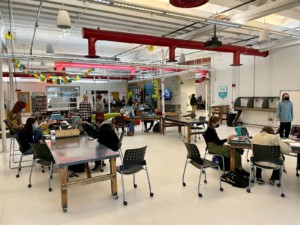A Blended Environment: The Future of AI and Education

Oftentimes when people think of artificial intelligence, images of robots, Skynet and a central command center immediately come to my mind.
I think of that scene from Terminator 2, when a heavily armed robot crushes a human skull beneath his feet. He’s controlled by another robot, who calculates every human move with efficiency and precision.
But that’s not really what AI is. AI is more complex than that.
What is AI?
AI is a backend algorithm developed by Youtube to connect user videos to the appropriate audience. AI is chat bots that provide timely customer service and direction to users across multiple platforms. AI is the intuitive cloud spreadsheet that provides immediate analysis and trends to its human programmer. It’s the digital nervous system that ideates original designs for car companies, based on thousands of past models. It’s the unbeatable chess player “Alpha Zero” that uses intuition and future forecasting to defeat the most skilled opponents. And finally, it’s the brilliant Watson robot, which sifts through thousands of past case studies in order to suggest the best course of action for current cancer treatment.
In other words, true AI doesn’t work against humans–it works with us, in a blended environment that draws upon a combination of abilities that provide for the best outcome.
According to Dave Evans, managing director of @accessplanit, AI “seeks patterns, learns from experience, and self- selects the appropriate responses in situations based on that.”
Or put more simply, AI is both a “machine that collects data;” and a “system to understand it.”
How has it helped?
Although misunderstood and still in its infancy, companies that have managed to incorporate AI show impressive results. Companies with at least 20% revenue growth use AI in 60% of their overall operations and automation, as compared to companies with negative growth that only automate 35% of their processes.
AI has also led to job creation in new sectors. In the finance sector, new positions opened up with the introduction of teller machines; including loan specialists, investment advisors, and other more ‘relationship-based’ services. Top employers insist that AI has helped humans spend their time on more creative pursuits and less time on the mundane administrative tasks.
What are the implications for AI in school?
In order to adequately prepare students for a future blended workforce that is part human and part AI, schools must mirror the same environment within their ecosystems.
In other words, schools must provide environments that couple the creative intelligence of humans with the analytical intelligence of computers and robots.
The Five Major Shifts AI will allow for Schools
Here are the five major shifts schools must make with examples of how AI is already expediting the process:
- Stand and Deliver Instruction ——————————————-> Facilitation/ Coaching
In an information age, with content available with the click of a mouse, teachers must shift from the ‘sage on a stage’ to the ‘guides on the side.’ Virtual environments have already allowed teachers to make this shift. USC Institute for Creative Technologies is prototyping a virtual learning program that combines AI and 3-d animation to guide students through learning content and platforms. Personalized characters serve as instructors, and help individualize instruction based on user responses and input.
Coaches help students set goals and reflect on their growth in the environment, while also setting up more lengthy open-ended projects to ensure students apply the content toreal-worldd situations. This blended environment allows teachers, students and machines to work symbiotically.
2. Developers of content———————————> Developers of learning experiences
As teachers, our most valuable asset is time. Before the onset of AI, much of a teacher’s time was spent developing and delivering content in a rigid, inflexible curriculum framework. When I first started teaching, I spent nearly all my prep time creating lessons, with little time left to meet with and develop students. Now, AI is able to do the more mundane work for us. Programs like Khan Academy and Thinkster Math help progress students through a range of math curriculum according to their ability levels.
In this environment, teachers and peer tutors are able to pull small groups of students aside to offer a more human and personalized approach. Huddled in a semi- circle around a whiteboard, a student works through a challenging problem with their peers, while the teacher provides anecdotal commentary regarding where students might have gotten hung up. Students then work out the problems on writable desks as their peers help monitor their progress.
3. Siloed Classrooms —————————————–> Virtual Social Networks
Before the onset of AI and collaborative virtual networks, students and teachers were often siloed by the walls of their classroom or boundaries of their school. Virtual social networks are now helping to break down those walls, offering students the chance to connect with and learn from peers world wide. Brainly, a social media site for Q & A, is a platform that connects users to fellow peers able to answer subject- specific questions. For example, say a student is struggling with understanding the principle that force= mass x acceleration. They type in their question on Brainly and are connected to a short narrated video that uses modern day Marvel characters to explain the concept. If they wish to ask follow up questions, they are connected through to the student creator of the video via a chat box.
In this example, AI has not diminished the value of humans, but has enhanced it by connecting two students millions of miles apart.
4. Textbooks and Set Curriculum ————-> Blended Courses and Customized Design
Back in college, my most dreaded time of the year was at the beginning of a new course. With the little money I had, I was required to purchase a set of textbooks and supplemental workbooks for each of my classes. If there was a “New Edition,” it was even more costly.
Fortunately AI has helped helped reverse this trend while also providing a more personalized experience for students. It’s also helped teachers in the creation process. Content Technologies, the brainchild of Cram101 and JusttheFacts 101 allows teachers to input course syllabi and then uses a CTI engine to help organize the content in a beautiful design organized around the core concepts. The teacher can then modify design and re-organize based on each student’s needs.
Instructors can create even more comprehensive blended courses through sites like Teachable, Udemy and CourseCraft. These sites create a blended learning ecosystem that couples coaching with content acquisition through videos, group chats, editable worksheets and varied assessments.
5. Hierarchical Top-Down Network ————————> Lateral Virtual Global Network
How does your school/district provide professional development? In the past, my professional development was usually mandated by administration. A school board would go away and develop site specific goals, and then hire the appropriate experts to offer the trainings. As a teacher, I had little input over the trainings I attended.
Fortunately, with the development of AI and global learning ecosystems, we have more control over and access to professional development opportunities. Virtual Global Conferences like Google’s “Education on Air” and “The Global Education Conference” provide a range of workshops and training for educators spread across a multitude of topics. After signing up for the conference and inputting in your specific goals, you are connected to the training most likely to meet your needs. You can also offer training on topics you feel most comfortable delivering.
In Closing/Where to Start
For many of us, using AI in our schools seems light years away. Some of us are still struggling to understand how to best use our new cloud platform, let alone something like an advanced learning ecosystem. I get it. I used to be there.
But what I have found is that successfully integrating AI starts by taking a single first step.
Adopt the mindset that you will ‘learn as you go.’ Pick a fully-developed online learning platform like Khan Academy, and integrate a few modules into your units. Sign up for a virtual conference (you can find those here). Create a blended virtual module of learning around one of your favorite lessons (find that here). Reserve one class period for students to connect to global peers through Brainly.
AI doesn’t have to scare us. By slowly and consciously embracing it, we can start to make the shifts necessary for the 21st-century classroom.
For more, see:
- Ask About AI: The Future of Learning and Work
- Artificial Intelligence in Education: Where It’s At, Where It’s Headed
- The Value of the Human in an AI World
Stay in-the-know with all things EdTech and innovations in learning by signing up to receive the weekly Smart Update.








AIAT GST INSTITUTE
Hey, Your Article about future environment education was very nice.....
Jincy Joy
It's very amazing to see how AI is transforming the human race. Rebranding the education sector with the help of AI is indeed the need of the hour and the suggestions/pointers that you have put forward is definitely a big step towards initiating this shift.